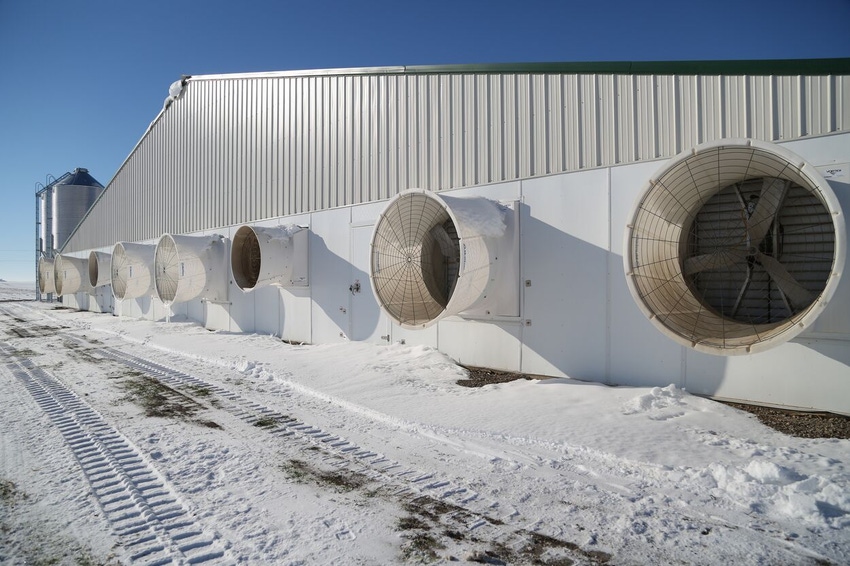Prepping barns for winter
During the colder months, swine barns are always faced with what Ramirez calls a “conundrum of energy efficiency versus air quality.”

When it comes to prepping barns for winter, Brett Ramirez says it’s important to really drill down on three key action items. The first being, to look at the pigs and note their behavior.
“They're going to be your best indicator if they're too cold, too hot, or just right. They're also going to give you that indication of where the best and worst parts of the pen are, suggesting, do I need to adjust inlets or seal up leaks? Then, ask yourself, what are they doing? Are they agitated? Are they all lying? Are they all doing some activity?” says the associate professor in the Department of Agricultural and Biosystems Engineering at Iowa State University. “That's going to give you that information if the environment's not quite right.”
The second action item is to note the outdoor temperature and set point, as well as the controller, its stage and what equipment is being called for in terms of speed/opening percentage, etc.
“That’s when we ask ourselves, does this match with what's going on in the barn?” Ramirez says. “We kind of have to build that intuition for, based on the current conditions and information we have, what should be going on and does that seem reasonable?”
Finally, he says it is critical to routinely inspect equipment and perform routine maintenance to really make sure everything is indeed working.
“I've been in a lot of barns recently where I go in and stuff just doesn't work,” Ramirez says. “Numerous reasons why, but again especially going into winter, we need to make sure equipment is actually performing the way it is supposed to, or if they’re supposed to be off, make sure they’re properly switched off and just make sure all equipment is operating the way they're supposed to be.”
He notes it’s also important to remember the basics of ventilation and what it affects, such as air temperature, moisture level, airspeed across animals and odor and gas concentrations.
“We bring fresh air in, properly mix it to collect all that stuff, and then we take it out. That is the basics of the ventilation process, and when we fail to provide any of those three steps, it’s going to lead to inadequate ventilation,” Ramirez says.
With outdoor temperatures getting colder, it’s important to ventilate for moisture control, which is typically our minimum ventilation rate. The goal is to remove the excess moisture being generated by the pigs and any of the noxious gases created by pigs' manure and then combustion from unvented heaters. The result of under ventilating can lead to an accumulation of gases and/or moisture and lead to potential health and performance problems.
“I always like to remind everyone that prescribed ventilation rates, such as 2 CFM per pig are good design guides, and so that's where I start if I'm trying to advise on the number of fans and/or the speed that they need to operate at,” Ramirez says. “So, I'm going to start with the CFM per head, but really when we get into the operation, especially during winter, is we want to focus on the pigs and using measurements of temperature and humidity inside the barn and then adjust our ventilation system based on that feedback, and that's what's going to lead to a good environmental management inside the barn.”
During winter, barns are always faced with what Ramirez calls a “conundrum of energy efficiency versus air quality.”
“They can both be friends and foes. We want the best both, right? We want to save money by using less propane, but we also want a good environment with low ammonia, low CO2, low CO, acceptable humidity, that all affect that air quality aspect, so we need both,” he says.
The problem is as we increase ventilation in cold weather, that's going to increase energy demand for electricity, for the fans, and also the propane to heat that barn. As we decrease ventilation to save energy, it's going to cause the concentrations to increase and air quality to get worse.
“So really we're trying to find that optimum ventilation rate, that perfectly balances our humidity and pollutant concentrations with also at some level of energy usage that provides that acceptable air quality,” Ramirez says.
When assessing ventilation, there are some key tools to have or add to your toolbox:
Portable weather meter that measures temperature, humidity and air speed
Smoke sticks for visualizing any drops in cold air or identifying any leaks or drafts
Tape measure for measuring inlet openings
Manometer or static pressure gauge
Laser tachometer for checking fan speeds
Infrared temperature gun for checking warm and cold spots
Volt or multi meter for checking electrical components
Gas detection tubes or sensors to monitor ammonia or carbon dioxide
Ramirez says one of the most important parts of prepping barns for winter is making sure pit fans are maintained, clean and functioning properly.
“Since we're in cold weather, we're going to be at a lot lower ventilation rates which means we're going to be running our pit fans almost all the time. Since these fans are going to be running 24/7 throughout winter. They need to be in tiptop shape and working the best,” Ramirez says. “The other problem is that if we push this off too long, they're going to be covered in snow, and nobody wants to walk around their barn with a 6-foot snow drift and try see if their pit fans are on or if it's even clean.”
Pit fans need effective air intakes, and that means at least two feet of separation between the manure and slats is needed to allow air to move into the pit fan. As manure starts to come up or if there's foaming, Ramirez says that's going to cause a restriction, and will make that fan work harder.
Other items to look for with fans:
Turn off unused fans.
Install plastic or commercial fan covers over unused fans.
Clean fan blades, motor housing and wire guards.
Ensure that fan shutters/louvers are clean and functional.
Inspect fan housing/frames for leaks and seal/repair.
Discharge cones and deflectors are intact and in good condition.
While it's easy to make sure fans are running and we're getting close to optimum ventilation rate, Ramirez says what is tricky is how to make sure we get that cold, fresh air distributed correctly.
“We need to make sure that cold air comes in, it has a chance to warm up and then by the time it gets down to pig level, it kind of slowly diffuses through the space, and it's not creating any drafts on the pigs,” he says. “We also want this air to be distributed uniformly. We don't want hot spots or cold spots throughout the house, and so by getting a good air jet and uniform mixing, we can ensure a nice even temperature throughout.”
For more advice from Ramirez and to access a complete winter ventilation checklist, be sure to download this recent publication from the Iowa Pork Industry Center to assist with this essential seasonal job.
About the Author(s)
You May Also Like




